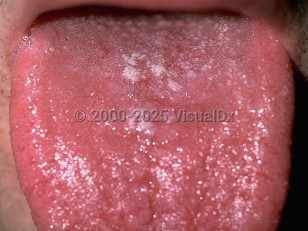Although not common in children aged older than 12 months, it may occur in children who are on antibiotics; who have an underlying endocrine disorder (eg, type 1 diabetes mellitus); who are immunosuppressed due to primary immunodeficiency disorders or secondary to malignancy, immunosuppressive medication, or HIV infection; who are on medications such as inhaled or topical corticosteroids; and who suffer from nutritional deficiencies (including iron, zinc, magnesium, selenium, folic acid, and vitamins A, B6, B7, B12, and C).
The child may be symptom free or may complain of a burning tongue and soreness or pain in the mouth or pain on swallowing.
Oral candidiasis occurs in children in 3 main clinical forms. The most common form in children is the pseudomembranous variety: white plaque formation typically appears on the tongue, lips, inner surface of the cheeks, and palate and can leave behind punctate bleeding and patches of reddened mucosa when scraped.
In children with HIV, oral thrush is the most common candidal infection. The presentation, however, differs, and these children may show signs of all of the types of mucous membrane infections.
Candida at the corners of the mouth is known as angular cheilitis or perlèche. Crusting, small ulcers, or fissures can be present at the angles of the mouth.
In median rhomboid glossitis, a smooth, red, diamond-shaped area is present on the dorsal surface of the tongue.
Oral candidiasis may be a feature in several syndromes:
- Autoimmune polyglandular syndrome type 1 (APS1), also known as autoimmune polyendocrinopathy-candidiasis-ectodermal dystrophy (APECED), is a rare monogenetic condition underlying autoimmune regulator (AIRE) gene mutation on chromosome 21q22.3. Patients present with the classic triad of atopic dermatitis, hypoparathyroidism, and chronic cutaneomucosal candidiasis.
- Chronic mucocutaneous candidiasis is characterized by recurrent or persistent candidal infections of the mucous membranes, skin, and nails due to defects in the host defenses against Candida species.
- Hyperimmunoglobulinemia E syndrome (hyper-IgE syndrome) represents a group of multisystem immunodeficiency disorders characterized by atopic dermatitis, recurrent cutaneous and systemic (usually pulmonary) infections including candidiasis, and variably high levels of IgE.
- Severe combined immunodeficiency (SCID) is a group of heterogeneous disorders with similar clinical pictures but variable defects resulting in severe dysfunction of T and B cells. Failure to thrive (poor feeding and low weight gain), chronic diarrhea and infections (especially pneumonias, otitis media, and skin infections), mucocutaneous candidiasis, and skin eruptions mark the course of disease. Graft-versus-host disease (GVHD) from maternal cell engraftment occurs in about half of patients.
Related topic: angular cheilitis



 Patient Information for
Patient Information for 
